Protect Against Lightning |
||
Lightning has not changed since the days when Benjamin Franklin flew his special kite during storms. Contrary to some peoples' belief, he did not "discover electricity;" rather, the experiment proved his theory that lightning was a form of electrical discharge. Maybe someone has already pointed this out, but in effect Franklin put into service the world's first lightning rod. The conductive (wet with rain) hemp rope between the metal wire spike on the kite and ground (the plate of a Leyden jar) performed the task a lightning rod is meant to do - lower the difference of potential between the charged clouds and ground, thereby reducing the likelihood of an electrical discharge. An induced current traveled along the rope and charged the Leyden jar. If lightning had actually struck the kite as fables suggest, Franklin would probably have been killed even though he was holding on to a silk string attached to the bottom of the hemp string to provide some insulation. Mr. Kirchhoff's current law would have apportioned the lightning strike current at the knot joining the two strings according to the respective resistances of Mr. Franklin-to-ground versus the Leyden-jar-to-ground - enough to fry both entities beyond recognition. Based on those experiments, Franklin installed lightning rods on the tallest buildings (made mostly of wood and brick) in Philadelphia and put an abrupt stop to the scourge of fires that had been devastating increasingly densely cramped cities. Why didn't the shorter buildings then get hit instead? A zone of protection around the lightning rod extends down at roughly a 30° angle (actually a defined radius profile rather than a straight line), thereby shielding the others. The idea caught on quickly around the world. Protect Against Lightning Protect your family and eliminate a serious fire hazard in your home by installing a simple, inexpensive arrester. "We were sitting in our library looking out at the storm." With this undramatic start an eyewitness describes one of the most terrifying things that can happen - being right under a lightning bolt. "Suddenly there was a snapping crackle and a roar - and a ball of fire that looked to be 4 or 5 feet in diameter hit the corner of the house where the antenna was attached. I was blinded for an instant and then saw a wisp of smoke curl from the window. I smelled smoke, and put some CO2 inside the corner of the house and into the air space between the Celotex ceiling and the roof. Antenna hardware showing the burns and scars of a direct stroke. Note burn on rim of flange, and the molten screw head. No trace of missing relay arm was ever found. Half of the Bakelite coil form also disappeared. The wire in the twin-lead fused and blew holes in the plastic. Wire of #10 gauge will carry current without strain. "The antenna was down - the three sections still intact ... The bolt apparently hit the tip of the antenna as it has marks that very much resemble the pit marks left when you quickly pass an electric welding torch across a piece of iron - a lot of little spatter marks." Every day lightning strikes somewhere. Usually it strikes high objects. Sometimes these objects are radio antennas. "But will lightning hit my antenna?" you ask. "And if it does - what will happen?" Chances are lightning will not hit your antenna, but protection is so simple and inexpensive that anyone is foolish to take even the small chance. Because if lightning does hit, it may mean anything from simple inconvenience to explosions and "curtains." The accompanying chart prepared by the U. S. Bureau of Standards, shows the number of lightning-storm days per year in different localities. However, it doesn't really matter if you expect ninety or just five storms this year - all you need is one, if it hits. In the first place, if lightning is so powerful, how can we possibly protect ourselves? The answer lies in the very composition of lightning bolts and the fact that despite their awesome nature, they are really mostly noise. A fair-sized bolt doesn't carry much more electrical power than it takes to start your car on a cold morning.
Table 1 - Lightning arrestor gap spacing versus peak voltages. True, there are voltages in the millions, and currents in the thousands - but this power is "turned on" for such a small fraction of a second that a conductor of adequate size doesn't have time to get warm before the show is over. Also, it is well known that to do any work; electricity must pass through a "load resistance." Keep your antenna circuit free from resistances, and there is nothing for the heaviest charge to go to work on - it's that simple. Simple transmitting antenna arrester is made from a rod, drilled and tapped for 1/4-20 brass bolt and a bolt-head electrode in a heavy lug on the lead-in insulator. The gap can be set to proper spacing with feeler gauge, a numbered drill, or a wire. For the maximum protection, follow this technique. Here the antenna's downlead attaches to one side of a safety gap supported by a porcelain stand-off insulator. A lightning choke is installed in the lead to the equipment used with the antenna. Television receivers can be given positive protection by means of a lightning choke which is installed on the equipment side of a conventional arrester. Bureau of Standards map shows lightning storms per year in various areas. Add to this the fact that a lightning bolt has such a steep front that any inductance whatever offers a terrifically-high impedance, and you have the secret of lightning protection: provide a straight shoot to ground for the bolt, and let the wires for signal currents have a little inductance. An "electronic switch" in the form of a simple spark gap will automatically ground the antenna whenever one of these noisy visitors comes charging down the wire. Table 1. Protection is fairly simple with receiving antennas. There are over twenty different lightning arresters on the market that will keep the insides of your set from melting, when they are properly installed. But nobody has ever done very much in the way of making lightning arresters for transmitting antennas. Broadcast stations make up their own systems, and amateurs usually get by on crossed fingers. Here is how to protect your transmitting antenna. First of all, unless yours is a very low-powered transmitter, don't try to use one of the broadcast or TV arresters. Their spark gaps are not designed to withstand the comparatively high voltages applied to transmitting antennas, and the arrester usually breaks down and short circuits the antenna the first time power is turned on. You can make an arrester quite simply just by providing a heavily-grounded spark gap. This may be improvised out of stand-off insulators, a metal rod, and ordinary nuts and bolts. The photographs give the story. Spacing of the gap should be the minimum that will withstand the peaks of your transmitter-feeder voltage. With a low-impedance feedline, or at the bottom of a quarter-wave grounded antenna, the gap can be very close. But if the antenna operates in the half-wave mode, or if it has high-impedance feed, greater spacing is required. This spacing can be determined experimentally, but if you know the antenna impedance at the point of lightning-arrester connection (which you can find with an antenna-impedance bridge, or the popular "Antennascope") and the power output of your transmitter, you can calculate the effective voltage at this point by using the formula: EQUATION HERE Peak voltage will be 1.41 times this value. Then, allow spacing according to Table 1. The gap can be set with a "feeler" gauge, or measure the proper diameter with a drill from a numbered-drill set. The lead from the arrester to your equipment can present even higher impedance to the lightning if you install a "lightning choke," which is simply a small coil. The inductance is not critical, so the choke can be a few turns cut from self-supporting coil stock or 18" of copper tubing formed around a 2" mandrel. The same added protection can be given the TV receiver, or conventional radio, by wrapping a few turns of the lead-in wire into a self-supporting coil on the equipment side of the arrester. This coil can be secured with Scotch tape. It should have no appreciable effect on signal currents, while at the same time strongly encouraging the lightning bolt to be on its way to ground, rather than to take the long route into the house. The middle of a storm is a poor time to do the job! Make preparations for your protection now. Then, when one of those black clouds rumbles along, you need not be afraid of lightning.
Posted July 12, 2020 |
||






